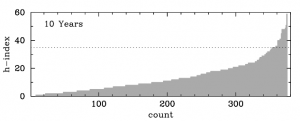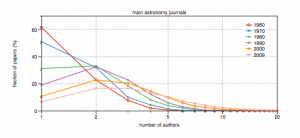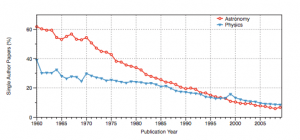At the beginning of every “normal” astrobite, we list three things: the title of the journal article being reviewed, the authors of the article, and the home institution of the lead author. In the past few weeks on the ArXiv there have been a few articles, which, instead of examining a new scientific concept, discuss some interesting trends they have observed in the authors of astronomical publications themselves. The first examines the citation records of Australian astrophysics and the second discusses the so-called “demise of the single author.”
Citations in Australian Astronomy
Paper Title: Citations to Australian Astronomy: 5 and 10 Year Benchmarks
Authors: Katherine Kenyon, Arjun Paramasivam, Jiachin Tu, Albert Zhang and Alister W. Graham
First Author’s Affiliation: Centre for Astrophysics and Supercomputing, Swinburn University of Technology
Scientists (including astronomers) tend to be both quantitatively minded people and, well… human. As a result we often enjoy trying to quantify how “successful” we are. In a culture dominated by the peer review and publication process, this often boils down some measure of how many papers a scientist has published and how many citations to their work there are (an article is cited any time a different article refers back to it). This assessment is rarely limited to simply counting the number of papers/citations an individual has, however. In fact, there is a special term for all the various methods used analyze both authors and journals of scientific literature: bibliometrics. Two of the most common metrics are:
The h-index: A scientist has an h-index of “n” when they have “n” papers which have a least “n” citations each.
The Impact Factor: A journal has an impact factor of “n” when the papers published in the journal two and three years ago received on average “n” citations in the past year.
And this is just the beginning. There are many other metrics, ranging from the serious, to the entertaining and very entertaining:
The g-index: Similar to the h-index. A scientist has a g-index of “n” when they have “n” papers that put together have “n”-squared citations
The author-normalized citation number: Similar to total citation number, but each individual paper has its total number of citations divided by the number of co-authors that were on the paper.
The Erdos Number: This measures the number of steps needed to get from an individual to Paul Erdos – a Hungarian mathematician who published over 1500 articles – via their co-authors. For instance, if someone published a paper with Dr. X, Dr. X published a paper with Dr. Y and Dr. Y published a paper with Erdos, they would have an Erdos number of 3.
The Erdos-Bacon Number: This is the sum of an individual’s Erdos number and Bacon number, where the Bacon number is essentially the equivalent of the Erdos number but for Kevin Bacon and film co-stars.
And yes… some people take that last one seriously… kind of…
The authors of this paper specifically examine the citation records for Australian astronomers based on papers published between 2001 and 2010. They first work to identify all PhD astronomers located at Australian institutions (finding nearly 400!) and then mine the NASA Astronomical Data System for information on their publications and citations. Two of their plots are show below. The first is a histogram of the h-index for 375 Australian astronomers over 10 years, and the second is the author-normalized citation count for the same group. The formal offered additional evidence to an existing theory that membership in large observational collaborations tends to increase ones h-index above the mean value (of the top 12 Australian astronomers, eight were members of the 2 degree Field Galaxy Redshift Survey and one of the Sloan Digital Sky survey), while the latter attempts to account for the fact that publications with many authors tend to be cited more often than single author papers. They find that for the years 2006-2010 the top 10% and 1% of Australian astronomers have ~140 and ~400 author-normalized citations. This is much higher than the global values between 1999 and 2003 (~40 and ~170 according to F. Pearce, 2004). This effect may simply be due to a combination of the general growth of astronomy in the intervening years, and the amount a time given for citations to accumulate in the two studies (one year vs. six months). If you are interested in this, I highly recommend reading the rest of the article.

Histogram of author-averaged citations for Australian Astronomers based on for 2001-2010 (10 year) or 2006-2010 (5 year) publications.
The “demise of the single author”
Paper Title: Publication Trends in Astronomy: The Lone Author
Author: Edwin A. Henneken
First Author Affiliation: Smithsonian Astrophysical Observatory
The second paper is a very short notice which examines the how the number of single-author on astronomy publications in particular has evolved with time. The author uses a similar technique to the first paper: mining the Astronomical Data System for information. The two relevant plots are show below. The first shows how the distribution of the number of authors on papers published astronomy journals has changed between 1960 and 2009, while the second plots the percentage of publications by single authors for both astronomy and physics during this time period. One can see that in 1960 over 60% of astronomy publications had only one author, while in 2009 that value was less than 10%, a decline that is much steeper than that seen in physics in general. This decline is most likely due, at least in part, to the increased frequency of mega-collaborations (e.g.2dF, SDSS, 2MASS, DEEP, UKIDSS, the Geneva Extrasolar Planets Search Program, the California Planet Survey, and many more) which tend to have lengthy author lists.




just a quick comment on the h-index: as recently shown by Henk Spruit (arXiv:1201.5476), in astronomy an author’s h-index can be estimated with a precision of around 10% to be $h=0.5(\sqrt c+1)$ where c is the number of citations. In other words: the h-index doesn’t add any useful information compared to just stating how much somebody’s work has been cited…
I should have added to my previous comment that Kenyon et al are aware of this relation, my point was that I think this simple relationship between total number of citations and the h-index should have been mentioned in the summary – they “just” show the (impressive) large number of citations that many Australian astronomers receive.
Glad I’m not alone in my closet fascination with citation analysis.
For interest, there have been some other approaches to new metrics. The most interesting, IMO, is use of Google’s PageRank algorithm on citation networks. Check out, for example,
http://arxiv.org/abs/0901.2640
http://www.cmth.bnl.gov/~maslov/citerank/Papers.php